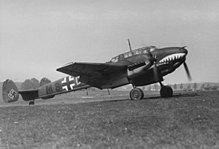Nose art
This followed the official policy established by the American Expeditionary Forces' Chief of the Air Service, Brigadier General Benjamin Foulois, on 6 May 1918, requiring the creation of distinct, readily identifiable squadron insignia.True nose art appeared during World War II, which is considered by many observers[7] to be the golden age of the genre, with both Axis and Allied pilots taking part.[citation needed] The Commonwealth pilots were withdrawn to Egypt and refitted with Curtiss Tomahawks (P-40) off the same assembly line building fighter aircraft for the American Volunteer Group (AVG) Flying Tigers being recruited for service in China.In November 1941, AVG pilots saw a color photo in a newspaper of a shark mouth painted on a 112 Squadron P-40 fighter in North Africa and immediately adopted the shark-face motif for their own P-40Bs.[8] The shark-face is still used to this day, most commonly seen on the Fairchild Republic A-10 Thunderbolt II (with its gaping maw leading up to the muzzle of the aircraft's GAU-8 Avenger 30mm cannon), especially those of the 23d Fighter Group, the AVG's descendent unit, and a testament to its popularity as a form of nose art.[16] Contemporary research demonstrates that bomber crews, who suffered high casualty rates during World War II, often developed strong bonds with the planes they were flying, and affectionately decorated them with nose art.[19] The artistic work of Alberto Vargas and George Petty's pin-up girls from Esquire Magazine were often duplicated, or adapted, by air force crews and painted on the nose of American and allied aircraft during World War II.In many other cases at airfields throughout the Middle East during the War on terror, aviation units instead painted the reinforced concrete T-walls and Bremer barriers that protected the aircrews and aircraft with elaborate murals and graffiti.[25][page needed] For example, Mickey Mouse adorned a Condor Legion Messerschmitt Bf 109 during the Spanish Civil War and one Ju 87A was decorated with a large pig inside a white circle during the same period.Perhaps the flashiest Luftwaffe nose art was the red and white viper snake insignia running through the whole fuselage of certain Junkers Ju 87 Stuka dive bombers that served with the II Gruppe, and especially the 6.[30] The markings of aces were often adopted by their squadrons, such as Galland's Mickey Mouse and Hartmann's black tulip (still in use until recently on the aircraft of JG 71 "Richthofen" – not known to be in use on the unit's new Eurofighter Typhoons).[31] A 2015 US Air Force memorandum stated that nose art must be "distinctive, symbolic, gender neutral, intended to enhance unit pride, designed in good taste."








nose jobnose-jewelsnose piercingLockheed P-38 Lightningpaintingfuselageaircraftfolk artgraffitianonymousephemeralVirgin GroupliveryEskimoAlaska AirlinesU.S. NavyVIII Bomber Command301st Bomb GroupItalianGermanflying boatpropellerspinnerWorld War IAmerican Volunteer GroupFlying TigersSopwith DolphinRoland C.IIFrancesco BaraccasquadronAmerican Expeditionary ForcesBrigadier GeneralBenjamin FouloisSPAD S.VIIcavallino rampanteFerrariEddie RickenbackerWorld War IIgolden ageAlliedRoyal Air ForceRoyal Canadian Air Force39th Pursuit SquadronBell AircraftMesserschmitt Bf 110sLuftwaffeZerstörergeschwader 76Gloster GladiatorNo. 112 Squadron RAFCurtiss TomahawksNorth AfricaBengal tigerV for VictoryWalt Disney Company39th Fighter SquadrontheatreLockheed P-38 LightningsFairchild Republic A-10 Thunderbolt II23d Fighter GroupConsolidated B-24 LiberatorFifth Air Force64th Bomb Squadron43d Bomb GroupSouthwest PacificTony Starcer91st Bomb Group (Heavy)Eighth Air Force"Memphis Belle"ChicagoB-24 Liberator834th Bomb SquadronRAF SudburyAlberto VargasGeorge PettyEsquireBoeing B-29 SuperfortressErnie PyleKorean WarA-26 InvaderC-119 Flying Boxcarfighter-bombersVietnam WarLockheed AC-130 gunshipsU.S. Air Force Special Operations SquadronsMinigunGulf WarOperation Enduring FreedomIraq WarStrategic Air CommandMemphis BelleWar on terrorT-walls and Bremer barrierspinupsRita HayworthBetty GrablecartoonDonald DuckBugs BunnyPopeyeYankee DoodleSam Spadeplaying cardsGrim ReaperPacificEuropeMesserschmitt Bf 110Mickey MouseCondor LegionMesserschmitt Bf 109Adolf Gallandcontemporary telephoneBreslau-Schöngarteninvasion of PolandSKG 210Erich HartmannJagdgeschwader 54ThüringenJunkers Ju 87Sturzkampfgeschwader 2North Africa campaignSoviet Air ForcesslogansFinnish Air ForceCurtiss P-36Japan Air Self-Defense ForceValkyrie